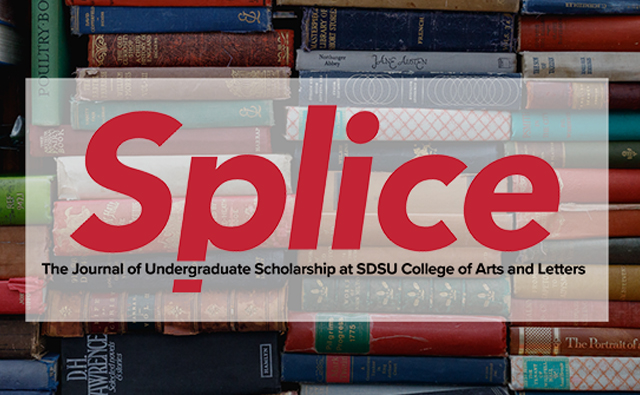CAL Undergraduate Journal Returns Following Pandemic Hiatus

Students in the College of Arts and Letters at SDSU are immersed in scholarship, and that extends beyond the classroom. This experience provides students with a platform for lifelong learning and career readiness.
Splice, CAL’s student-led journal, seeks to further empower undergraduate students through the dissemination of their scholarship.
Splice: The Journal for Undergraduate Scholarship at SDSU College of Arts and Letters (JUSCAL), was established in 2015 as the first humanities and social sciences undergraduate journal in the CSU system. The journal has been on hiatus for two and a half years following the COVID-19 pandemic.
In spring 2023, Splice will return with the publication of its sixth volume.
The journal is initiated, organized, and directed by students, for students. CAL’s director for undergraduate research, Elisa Sobo, provides guidance to the 30-plus students forming the Splice Collective. Funding comes mostly from a Student Success Fee initiative grant.
Fourth-year English majors Corina Enriquez and Cecelia Liefeld lead the journal as co-editors in chief.
“Undergraduate journals give students a chance to see what goes into publishing a research paper, which is required of students in many graduate programs,” Liefeld said. “Students can test the waters, see if they feel passionate about the process and can gain valuable experience that they can take with them to graduate programs as well as the ability to research and think critically outside of academia.”
Splice also gives students the opportunity to get firsthand experience in other aspects of academic publishing such as acquisitions, financing, peer-reviewing, copyediting, and marketing. “Many careers demand the kinds of skills that working on Splice helps cultivate,” noted Sobo.
Social sciences major Melanie Hussey said she is hopeful about Splice’s mission of empowerment and community building.
“Undergraduate journals give students the opportunity to showcase their hard work and dedication to educating not only themselves, but their peers. They promote a sense of community because the student body is able to recognize their friend's or fellow classmate’s work and feel proud of them,” Hussey said.
Sobo corroborated, noting that “social belonging is crucial to retention and graduation rates, which research confirms are higher when undergraduates are directly engaged in projects like this. Gains are especially notable for students from groups underrepresented in academic settings.”
Enriquez shared the excitement about Splice’s “goal as a journal to cultivate a community that is excited about CAL research, willing to extend research opportunities to students that want to spread their knowledge to their peers.”
Splice will have a public launch party to celebrate the publication during the upcoming spring semester. For more information about Splice, or to volunteer to work on the journal, please contact Elisa Sobo at [email protected] or write to the editors at [email protected]. You can also find the journal at cal.sdsu.edu/splice and on social media @splice_sdsu.
